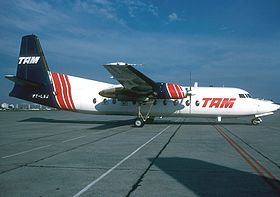Air accident at the TAM Linhas Aéreas in Bauru in 1990
| Air accident at the TAM Linhas Aéreas in Bauru in 1990 | |
|---|---|
|
A similar Fokker F-27 from TAM |
|
| Accident summary | |
| Accident type | Engine failure during go-around |
| place | near Bauru , Brazil |
| date | February 12, 1990 |
| Fatalities | 1 |
| Survivors | 40 |
| Fatalities on the ground | 2 |
| Aircraft | |
| Aircraft type |
|
| operator |
|
| Mark |
|
| Departure airport |
Sao Paulo-Congonhas Airport , Brazil |
| Destination airport |
Bauru Airport , Brazil |
| Passengers | 38 |
| crew | 3 |
| Lists of aviation accidents | |
The TAM Linhas Aéreas aircraft accident in Bauru 1990 occurred on February 12, 1990. On a domestic flight of the Brazilian airline TAM Linhas Aéreas from São Paulo to Bauru , a pilot error caused the engine of a Fokker F-27 Friendship 200 to misfire , which then crashed. Three people were killed in the incident.
plane
The aircraft concerned was a 1962 built Fokker F-27 factory number 10206. The aircraft with the factory number 10206 was finally assembled at the Fokker factory in Schiphol and made its maiden flight on July 20, 1962. The twin-engine short - haul aircraft had 2 turboprop Rolls- type engines -Royce Dart 532-7 equipped. On August 6, 1962, it was delivered to DETA Linhas Aereas Mozambique , where it was operated with the aircraft registration CR-AIC and was given the name Quelimane . In September the machine was rewritten to the registration number C9-AIC . After the airline was renamed LAM - Linhas Aéreas de Moçambique , the machine was officially operated under the name of this airline from May 1980. In November 1981 the machine was taken over by the American aircraft leasing company Manufacturers Hanover Leasing and from November 1982 leased to the Brazilian VOTEC , which was renamed on August 1, 1986 in Brasil Central Linhas Aéreas, which in turn was transferred to TAM - Transportes in 1990 Aéreos Meridionais was taken over.
the accident
The Fokker took off from São Paulo-Congonhas (CGH) on a domestic flight to Bauru. The pilot in charge was a flight captain in training who was accompanied by an instructor and an examiner. Due to congestion in the frequency of the Brasília District Control, the descent was initiated from an altitude of 14,000 feet when the plane was 50 kilometers from Bauru, instead of the usual 75 kilometers. After a rapid descent to 4000 feet (approx. 1220 meters), the plan to carry out an instrument approach was discarded and the crew continued with an approach on runway 32 according to visual flight rules. The pilot in charge felt uncomfortable because the machine was flying too fast and too close to the airport. The instructor wanted the approach to be continued and instructed the pilot to lower the landing gear and switch the lift aids from 16 to 40 degrees. The machine's speed decreased to 135 knots (approx. 250 km / h), which was still too fast. After the pilot asked his instructor again who was going to land the machine, he replied that he should carry out the approach and landing. The pilot was unsettled by the fact that the instructor was also holding onto his steering column. Due to the incorrect approach configuration, the pilot asked again who would make the landing and stated that he wanted to fly a holding pattern in order to correct the orientation of the aircraft for the landing. Eventually the instructor took over the helm. The engine thrust was reduced and the aircraft was brought into a horizontal position in order to slow it down and correctly configure it for landing. The Fokker was sinking at a high speed of 2500 feet (about 760 meters) per minute, while the speed was still 130 knots (about 240 km / h).
The machine touched down 775 meters behind the threshold and first on runway 32 with the nose wheel. The aircraft then jumped up again, hovered over the runway and touched it alternately with the right and left main landing gear. The instructor realized that he would no longer be able to stop the machine on the remaining section of the runway. He then initiated a go- around . In doing so, he did not gradually increase the thrust, as stipulated in the operating manual, but suddenly. The temperature display for the turbine exhaust gases (TGT) then rose to the critical range. The engine combustion chambers were receiving too much fuel. Due to the low rotational speed of the propellers, not enough air got into the engines to ignite the kerosene-oxygen mixture. There was a misfire. The steep angle of attack when climbing too much air was sucked into the engines. Both engines did not develop enough power to keep the machine in the air. The Fokker sank and collided with several obstacles on the ground, including a car. A fire broke out.
Victim
Initially, the Fokker's occupants could all leave the machine or be rescued alive. The two occupants of the car - 29-year-old mechanic Gisele Marie Savi Pinto and her four-year-old son Guilherme - were killed in the collision. A few days after the accident, the captain Paulo Sérgio Espósito also died from injuries sustained by the fire.
swell
- Aircraft accident report in the Aviation Safety Network
- Aircraft accident report on Desastros Aéreos (Portuguese)
- Operating history
Coordinates: 22 ° 20 ′ 26.3 ″ S , 49 ° 3 ′ 38.6 ″ W.
